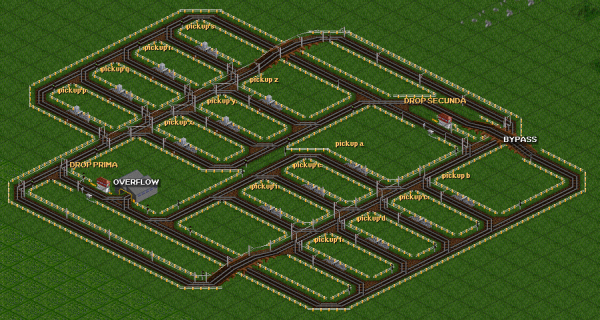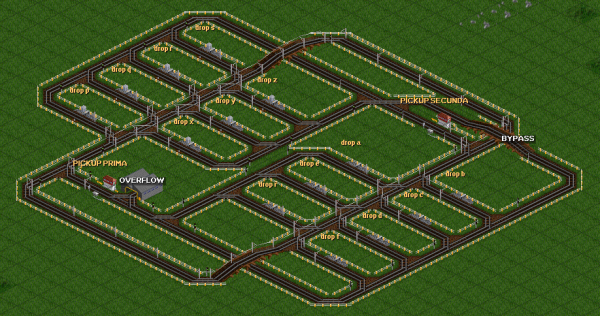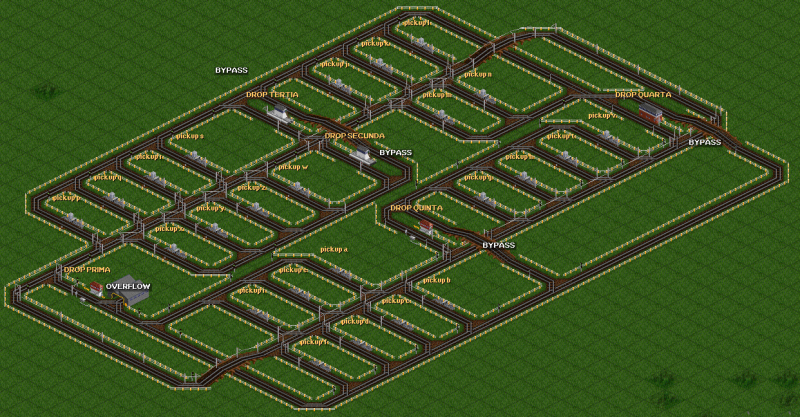Difference between revisions of "Multipoint Self-regulating Network"
From #openttdcoop wiki
m |
m |
||
| Line 8: | Line 8: | ||
As name suggests main difference from regular SRNW is introduction of addition drop/pickup points along the way with possibility to bypass them in case if station is not ready (very important in case if it is a pickup). There still only one order for dummy trains - go from PRIMA, secondary or tertiary drops are just happen to be in a way of "already used" dummy trains as they try to get to it. At same time SRNW limitation of single cargo type per network still applies. For pickup oriented networks where MSRN acts as local distribution for secondary cargo it is important to make sure that additional pickup points have a way for trains to bypass them in case if there is not enough cargo, so instead of piling up they would eventually get to overflow depots, or be used at other pickups which actually need more dummies. For drop stations similar approach needs to be taken where which is detailed in Timer Based Drop Stations article Since general design of MSRN is very close to SRNW it is possible to start from multiple SRNWs and then later combine them into single MSRN by removing extra overflow loops/injections and adding bypasses. In theory, MSRN will be more efficient than segregated SRNWs it is based from, in terms of earnings and train usage since there will be less "empty" run time as trains have multiple chances to serve needed stations per complete loop. However extra caution should be applied to priorities and penalties making possible for trains to enter and additional drops as needed since guiding trains on MSRN becomes relatively complex issue for pathfinder. | As name suggests main difference from regular SRNW is introduction of addition drop/pickup points along the way with possibility to bypass them in case if station is not ready (very important in case if it is a pickup). There still only one order for dummy trains - go from PRIMA, secondary or tertiary drops are just happen to be in a way of "already used" dummy trains as they try to get to it. At same time SRNW limitation of single cargo type per network still applies. For pickup oriented networks where MSRN acts as local distribution for secondary cargo it is important to make sure that additional pickup points have a way for trains to bypass them in case if there is not enough cargo, so instead of piling up they would eventually get to overflow depots, or be used at other pickups which actually need more dummies. For drop stations similar approach needs to be taken where which is detailed in Timer Based Drop Stations article Since general design of MSRN is very close to SRNW it is possible to start from multiple SRNWs and then later combine them into single MSRN by removing extra overflow loops/injections and adding bypasses. In theory, MSRN will be more efficient than segregated SRNWs it is based from, in terms of earnings and train usage since there will be less "empty" run time as trains have multiple chances to serve needed stations per complete loop. However extra caution should be applied to priorities and penalties making possible for trains to enter and additional drops as needed since guiding trains on MSRN becomes relatively complex issue for pathfinder. | ||
| − | [[File:LMSRN-D.png|800px|thumb||Larger MSRN-D]] | + | [[File:LMSRN-D.png|800px|thumb|center|Larger MSRN-D]] |
Revision as of 13:12, 25 February 2010
Multi-point Self-regulating Network (MSRN) is an enhancement of SRNW design aimed to help with adapting SRNW concept to capacity oriented industry sets such as PBI, ECS or FIRS.
Regular coopers approach with having single processing point for cargo type is not suitable for setup where an industry can only deal with set amount of delivered input over time. There is also another complication - processing speed grows over time as well as fluctuates a bit which requires a lot of station and train management. MSRN is based on same principles as SRNW but takes extra steps to deal with multiple drop or pickup points. MSRN can be equally used for "many pickups to few drops" or for "few pickups to many drops" scenarios, differences being which station design is used where. Pickups can be same as for SRNW (or at least be based on same principles) while drops could be designed as suggested in Timer Based Drop Stations
As name suggests main difference from regular SRNW is introduction of addition drop/pickup points along the way with possibility to bypass them in case if station is not ready (very important in case if it is a pickup). There still only one order for dummy trains - go from PRIMA, secondary or tertiary drops are just happen to be in a way of "already used" dummy trains as they try to get to it. At same time SRNW limitation of single cargo type per network still applies. For pickup oriented networks where MSRN acts as local distribution for secondary cargo it is important to make sure that additional pickup points have a way for trains to bypass them in case if there is not enough cargo, so instead of piling up they would eventually get to overflow depots, or be used at other pickups which actually need more dummies. For drop stations similar approach needs to be taken where which is detailed in Timer Based Drop Stations article Since general design of MSRN is very close to SRNW it is possible to start from multiple SRNWs and then later combine them into single MSRN by removing extra overflow loops/injections and adding bypasses. In theory, MSRN will be more efficient than segregated SRNWs it is based from, in terms of earnings and train usage since there will be less "empty" run time as trains have multiple chances to serve needed stations per complete loop. However extra caution should be applied to priorities and penalties making possible for trains to enter and additional drops as needed since guiding trains on MSRN becomes relatively complex issue for pathfinder.


